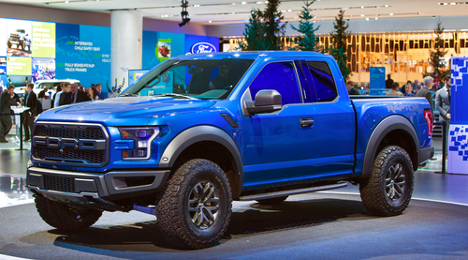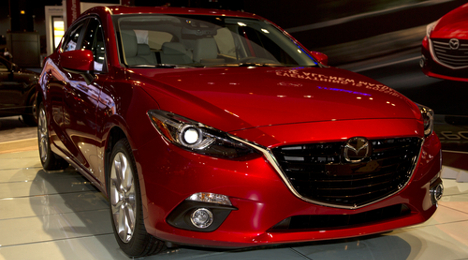There will likely be 1.96 million new vehicles sold in Canada this year, compared to 1.90 million in 2015, according to the latest Scotiabank Global Auto Report.
That also compares favorably to historical levels over the last quarter-century, which Scotiabank detailed in a data set included in the report.
From 1990 to 1999, new-car sales averaged 1.27 million in Canada. From 2000-2012, they were at 1.59 million. There were 1.74 million new-vehicle sales in 2013 and 1.85 million in 2014.
By province group, Scotiabank forecasts that this year, sales in Atlantic provinces will be even with year-ago figures (140,000), with annual sales in Central provinces (Quebec and Ontario) increasing from 1.21 million units to 1.27 million.
Meanwhile, new-car sales for Western provinces (Manitoba, Saskatchewan, Alberta and British Columbia) are expected to decline from 553,000 to 544,000.
As far as the most recently completed month, Scotiabank said, Canada’s new-car sales in November were up double-digits.
Scotiabank’s recently released Global Auto Report paints a rosy picture — one that pleasantly surprised analysts with the Toronto-based bank.
“We came into the year expecting global purchases to advance by about 3 percent,” Carlos Gomes, senior economist and auto industry specialist at Scotiabank, told Auto Remarketing Canada. “Through July, what we’ve seen is they’ve increased by 5 percent.
“We’re seeing labor markets continuing to do quite well. Labor markets are strengthening across developed markets. And that’s positive because it’s really the health of the labor market that drives vehicle sales."
Gomes noted a significant rebound in purchases outside of developed markets. “Last year sales in developing markets declined by 2 percent. That was the first decline that we’d seen since 2001. As economic conditions in emerging markets weakened, you had lower sales in developing markets. So the concern was when that was going to stabilize. What we’ve seen is they’ve seen a fairly nice bounce-back.
“We’re seeing most of Asia rebound nicely from last year’s declines,” he said, highlighting double-digit gains in China. “The only places where we’re still seeing weakness internationally is we’re still seeing large declines in Russia and more importantly, Brazil is the weakest market.”
The report notes that while gains are expected to moderate through year-end, 2016 represents the seventh consecutive annual new-vehicle sales increase and surpasses the previous upcycle that lasted six years. Strengthening labor markets and improving financial conditions suggest that the upswing will continue in 2017.
North American record
In North America, new-vehicle sales exceeded 20 million units last year for the first time in 2015, and have increased an additional 3 percent year-over-year through July.
Mexico is leading the North American sales gains, with volumes surging 18 percent so far this year, thanks to a strong labor market and accelerating credit growth. Auto loan growth has picked up 15 percent year over year, even as interest rates have started to increase.
Sales in Canada have gained momentum this year after last year’s record high of 1.9 million, with sales gains in seven out of 10 provinces.
U.S. sales rose to an annualized 17.9 million units in July, the highest level of the year. This rebound was driven by light trucks, as households replace aging sedans with crossover utilities and pickup trucks.
Scotiabank expects this trend will continue to lift sales, as more than 40 percent of the U.S. fleet is at least 13 years old, and there are still almost 50 million vehicles on the road that were built before 2000. The latest sales gain reduced U.S. inventories 2 percent below a year ago and points to continued output gains in the coming months.
North American sales are expected to top 21 million for the year.
"The health of the U.S. consumer is the main driver of the North American sales outlook, and most indicators continue to point to ongoing gains," the report noted. "U.S. job growth is advancing by nearly 2 percent year over year, vehicle affordability remains near record highs and there is no evidence of deterioration in the automotive finance market.
“As a result, we expect U.S. purchases to continue to move higher for the remainder of the year and in 2017.”
Focus on Canada
Vehicle sales are advancing in seven of 10 provinces. Ontario and British Columbia are leading the way with gains through June of 9 percent and 7 percent, respectively, with Alberta, Saskatchewan and Newfoundland seeing declines of about 7 percent, 4-5 percent and 1 percent, respectively, according to Gomes.
Volumes appear to be stabilizing in the hard-hit oil-producing provinces, with the decline in Alberta moderating in recent months from the double-digit fall-off reported through February, the report noted.
On the used side, prices in Canada have increased this year, Gomes said, after declines in early 2015.
He attributed this to both internal and external demand. “The Canadian dollar makes it attractive for U.S. dealers to come up here. Given that we have had a lot of demand from dealers in U.S., this gives lift in Canadian prices.
“Based on the info we are able to get from Statistics Canada surveys,” he continued, “used-vehicle sales in Canada are even stronger than the improvement in the new market.”
Click here to access the full report.
Mazda Canada and Hyundai Auto Canada Corp. each recently celebrated significant sales milestones during deliveries of some of the automakers’ most popular models.
First over at Mazda, OEM officials highlighted their two-millionth sale in Canada with one lucky customer, Bruno-Pierre Gougeon. The milestone vehicle sold was a 2016 Mazda3, which is Mazda Canada’s best-selling vehicle, with over half a million sold in Canada since 2003.
Perhaps not coincidentally, the automaker pointed out this vehicle was sold by Mazda Canada's largest volume dealer, Albi le Géant Mazda in Mascouche, Quebec.
To mark the occasion, Mazda Canada held a celebration event at Albi le Géant Mazda for the owner of the two millionth Mazda sold in Canada with members of Mazda Canada and the dealership in attendance.
In addition to becoming part of the Mazda family, Bruno also received two years of payments waived along with two years of complimentary maintenance.
“This is a great milestone achievement for Mazda in Canada, and is the result of our challenger spirit that springs from our heritage in Hiroshima, Japan,” said David Klan, senior director of sales, marketing and regional operations for Mazda Canada.
“We love to share our exceptional products with Canadian customers who also believe that driving matters — people like Bruno, who is proudly driving this milestone vehicle,” Klan continued.
Mazda Canada entered the Canadian market in 1968 with less than 1,000 sales in their first year. As the years passed and more models were added to the lineup, the sales also grew with the model count.
The first full year to hit 10,000 sales happened in a mere three years, in 1971, and the next milestone of 50,000 annual sales occurred in 1991.
The most popular vehicle in 1991 was one of the vehicles that kicked off Mazda’s history in Canada — the B-Series truck.
500,000th Hyundai Elantra sold in Canada
Hot on the heels of the February launch of the all-new 2017 Elantra compact sedan, Hyundai Auto Canada announced it has reached a sales milestone with the Elantra nameplate, achieving 500,000 cumulative sales since June 1991.
The automaker indicated the milestone sale — a 2017 Elantra GL — recently was delivered to a customer in Montreal.
With the arrival of the 2017 model, six generations of Elantra models have been displayed in Hyundai dealership showrooms coast-to-coast. For company executives, the all-new Elantra has some big shoes to fill.
“The fifth generation Elantra won both North American and Canadian Car of the Year awards in 2012 and has been Canada’s second-best selling passenger car since 2013, so we have high expectations for this all-new vehicle,” said Don Romano, president and chief executive officer for Hyundai Auto Canada.
“The Elantra, in all of its versions, is our most successful nameplate, by far. It's the first Hyundai vehicle to reach 500,000 sales and is an important player in the country’s compact car market,” Romano went on to say.
ADESA and Manheim have both released their respective used vehicle price indexes for the month of January and both reflect increases.
The ADESA Index, powered by ALG, reported that wholesale prices increased, on average, by 0.6 percent compared to December after adjusting for seasonality. The Manheim Canada January index increased by nearly 5 points from December, maintaining a year-over-year increase of 26.1 points.
According to Manheim, the month’s increase was bolstered by an increase in sports car values (which had a 25.6 point increase in January) and luxury values (which had a 6.7 point increase). Manheim says the only category that declined was the full-size vehicles, which dropped 3.2 points last month.
Looking at ADESA’s January numbers, price movements were positive for all segments. Minivans experienced the most rapid increase, seeing prices rise by 12 percent ($1,246), followed by midsize cars (6.9 percent, $636), mid-compact cars (5.2 percent, $388), full-size pickups (4.9 percent, $1,171), midsize SUVs (4.1 percent, $607) and compact SUVs (1.7 percent, $245).
According to ADESA, consumer confidence in Canada fell by 10.9 points in January to 80.1, the lowest level since the end of 2011. The unemployment rate rose by 0.1 percent to 7.2 percent, while the national gas price fell by approximately $0.10 per liter to $0.87 per liter.
Looking at the Canadian loonie, the value had fallen to a 12-year low by January 19, to $0.687 against the U.S. dollar, with a monthly average of $0.7051.
ADESA reports that overall light-duty vehicle sales in Canada increased by 9.6 percent year-over-year in January, with the SAAR currently tracking at 1.94 million units. January passenger car sales declined by 3.8 percent (to 33,826 units) year-over-year but light truck sales increased by 17 percent (to 74,727 units).
Scotiabank released its Global Auto Report this week, highlighting a record sales month in Canada for the month of May.
Carlos Gomes, the senior economist and auto industry specialist at Scotiabank, summarized May’s achievement.
“Sales in Canada set a record for the month of May, fueled by a 20 percent year-over-year surge in the purchases of luxury cars and light trucks,” Gomes said. “Luxury vehicles are the fastest-growing segment in Canada and across many nations this year. Purchases are being driven by rising household wealth – the key driver of the luxury auto market – which is being buoyed by strong equity market performance across much of the glove and ongoing house price appreciation.”
Scotiabank also attributes the recent trend in fuel prices as a contributing factor in the situation.
“Lower gasoline prices have also provided a big boost to Canadian luxury volumes this year, spurring purchases of large luxury SUVs,” Gomez said. “Through May, sales of these models have surged 87 percent year-over-year and now account for 3 percent of overall luxury sales, nearly double their share of the previous five years. In fact, the popularity of these models is approaching what has been normal in the United States in recent years, a country with much lower gasoline prices.”
Other highlights from the report, according to Scotiabank, include the following:
- Luxury light truck sales in Canada have advanced at more than double the pace of mass-market models. Increasing wealth has allowed many to reach beyond the entry-level luxury segment, which made up most of the growth in previous decades.
- British Columbia has a luxury penetration of 15 percent – almost 50 percent above the national average.
Check out the full Scotiabank Global Auto Report here.
Canada’s sole public dealer group hosted its quarterly conference call on Thursday, announcing its results in the first quarter of 2015.
In light of AutoCanada’s recent acquisition run, the group’s overall used vehicle units sold nearly doubled year-over-year from 2,861 in the first quarter of 2014 to 4,891 in 2015.
On a same-store basis, however, there was a slow-down in the first quarter. Although used-vehicle revenue increased by 2.8 percent, the number of units sold fell by 3.3 percent to 2,367. Same-store gross profit from used retail sales fell by 1.9 percent to roughly $4.2 million.
AutoCanada’s president and chief executive officer, Tom Orysiuk, classified the first quarter of 2015 as a “challenging period for the automotive retail sector in Canada, and especially in Alberta.”
“January and February were difficult months, although we started to see the cadence of sales improve in March,” Orysiuk said. “We are now entering the second quarter, the period where our sales volumes typically increase during the year, and we are cautiously optimistic in our expectations.”
When asked if there were any changes in the used-vehicle supply levels or leasing levels in Canada, the company’s president said things were “still tight.”
“Well there’s not a lot of leases out there and there hasn’t been for a while,” Orysiuk said. “We’re not seeing a big pick up there in most markets. In Quebec there’s definitely a lot of leases and we’ve got a pretty good process there to make sure we retain those customers.
“And on the supply side of used vehicles, last weekend I visited a couple of our dealers and both of them complained about how difficult it is to find good quality used vehicles. With used vehicles, the market we play in is that 2- to 5-year-old vehicle that is eligible for bank financing that’s hard to sell privately. Supply on that is still tight. It’s improving. It’s not where it was two years ago, but it’s still tight.”
A complete listing of AutoCanada’s 2015 first quarter results can be found here.
Dealertrack Technologies’ monthly TradeTracker Used Vehicle Market Report has been released for the month of March, and the one thing you need to know from it is that customer desires appear to have remained relatively consistent for the last year.
For the month of March, the overall most-appraised vehicle in Canada remains the stalwart Ford F-150, a trend repeated for the last three months and the last year. In fact, the rest of the top-five most-appraised vehicles also repeat those trends, and are as follows (in order of most appraisals): Toyota Corolla, Honda Civic (sedan), Mazda Mazda3, and Dodge Grand Caravan.
When you break down what types of dealers are appraising what types of vehicles, the consistency remains for the last month as well as the previous three-month and year-long trends. Domestic vehicle most appraised by domestic dealers? F-150. Import vehicle at import dealers? Corolla. Domestic vehicle at import dealers? Ford Escape. And import vehicle at domestic dealers? Mazda3.
It’s not until you analyze what trade-in owners are looking at that you find a slight fluctuation in what is otherwise business as usual. Domestic owners looking to trade in for another domestic vehicle were the most interested in the F-150. That is the case for March as well as a three-month trend and year-long trend.
Those same trends are also apparent for the top import vehicle looked at by import owners (Corolla) and the top import vehicle looked at by domestic owners (Toyota RAV 4). The only change comes with the top domestic vehicle looked at by import owners, which, in March, was the F-150 – a three-month and year-long trend currently held by the Escape but slowly being taken over by its larger Ford brother.
TradeTracker’s brand of the month, Toyota, also presented a model in consistency. The top-three off-make vehicles appraised by its dealers remain the same for the last month all the way up to the last year: the Civic (sedan), Mazda3 and F-150. Trade-in customers looking to pick up a Toyota were most interested in the Corolla in March, followed by the RAV 4 and the Yaris.
AutoCanada hosted its quarterly conference call on Friday, outlining its financial results for the fourth quarter and full year of 2014.
The group saw some of its largest year-over-year increases in a couple of its used-vehicle sectors: used-vehicle sales and parts, service and collision repair. For the fourth quarter alone, AutoCanada's same-store used vehicle retail revenue increased by 11.7 percent along with its same-store parts, service and collision repair revenue, which increased by 11.2 percent.
That trend was on par for the year as the group’s same-store used vehicle retail revenue for 2014 was also up by 11.2 percent while its same-store parts, service and collision revenue also increased, by 10.5 percent.
For an overall glance at the group’s successes for the year, the company’s massive number of acquisitions helped fuel a 57.2 percent increase in its revenue in 2014, an $805.7 million increase to roughly $2.21 billion. Gross profit for the year increased 51.7 percent to $373.1 million, a $127.1 million jump.
“We are proud of our annual 2014 results and our growth in units retailed, revenue, gross profit and net income are reflective of the 17 stores which we added to our family during the year,” said Patrick Priestner, the group’s executive chairman. “The past year was a milestone for AutoCanada as we exceeded $2 billion in revenue and reached $89 million in EBITDA. During the year we were entrusted by the manufacturers with four new brands including Cadillac, BMW, MINI and most recently, Kia in the form of an open point. We now represent eight manufacturers and 19 different brands, operate in eight provinces and employee over 3,400 dedicated staff. We are pleased with the dealerships we acquired this past year as they are integrating well into AutoCanada and we believe they will provide long-term value for our stakeholders.”
A complete listing of AutoCanada’s 2014 results can be found here.
Editor's Note: Stay tuned to Auto Remarketing Canada for further insight into Auto Canada's 2014 sales results.
Anyone who has read one of Dealertrack Technologies’ TradeTracker Used-Vehicle Market Reports in the last few months won’t be surprised by what they see, once again, on top of the appraisal charts.
The Ford F-150 remains the top overall most-appraised vehicle in Canada for the month of February, followed once again by the Toyota Corolla, Honda Civic sedan, Mazda Mazda3 and the Dodge Grand Caravan.
The F-150 maintained its three-month trend as the domestic vehicle most appraised by domestic dealers, while it was also the domestic vehicle most looked at by domestic owners looking to trade-in. Perhaps the only surprise of the month was the truck’s new spot as February’s domestic vehicle most looked at by import owners, a spot that was previously occupied for the last three months by the F-150’s crossover little brother, the Ford Escape.
The Escape did, however, maintain its achievement of being the domestic vehicle most appraised by import dealers, continuing to show Ford’s dominance, aside from several Japanese offerings, in the Canadian used market.
Speaking of Japan – nearly everything that wasn’t domestic on February’s TradeTracker report came from manufacturers based on its shores. The Corolla remains the import vehicle most appraised by import dealers while the Mazda3 kept its spot as the import vehicle most appraised by domestic dealers, both a continuation of three-month trends. The Corolla retook its spot as the import vehicle most looked at by import owners, a trend the Toyota RAV 4 holds for the previous three months. In a flip situation, the RAV 4 was the import vehicle most looked at by domestic owners, a spot contended for by the Corolla with the most for the year.
February’s TradeTracker brand of the month was Volkswagen, which further reflected the Japanese impact on the Canadian market. The Mazda3 was the most appraised off-make vehicle at VW dealers this past month, followed by the Hyundai Accent and the Subaru Impreza. As far as the vehicles most looked at by trade-in customers at VW dealerships, the list was completely dominated by Mitsubishi – in February, customers looking to trade in their VW were most interested in the Outlander, Lancer and RVR, respectively.
Canadian new auto sales – which totaled roughly 1.85 million units in 2014 – eclipsed the previous year by 6 percent, according to the Scotiabank Global Auto Report released this month. Unlike 2013, however, which had overall sales growth in all regions, the significant growth for last year was driven out of the central regions of the country.
“We expect sales to edge up to 1.86 million units in 2015, buoyed by ongoing job gains, low interest rates and near-record vehicle affordability,” said Carlos Gomes, Scotiabank’s senior economist and auto industry specialist. “Canadian exports have accelerated over the past year, advancing by 11 percent – the best performance since 2011. Shipments will be buoyed in 2015 by the strongest economic growth in the United States in a decade, as well as by the recent sharp depreciation of the Canadian dollar as a result of the slump in global oil prices.”
Scotiabank also highlighted the following from its Scotiabank Global Auto Report:
- Car and light truck sales in Ontario increased 11 percent in 2014, the first time ever selling over 700,000 units. Sales from these two areas are expected to increase to 726,000 this year.
- In Alberta, vehicle sales are expected to decrease from 2014’s total of 269,000 units to 263,000 units due to a reduction in oil and gas investment. Alberta’s labor market is expected to continue to grow, however, in line with the national average.
- Auto sales in Quebec are expected to strengthen to 423,000 units in 2015 with the anticipated strengthening of manufacturing exports.
The full Scotiabank Global Auto Report can be access online here.












